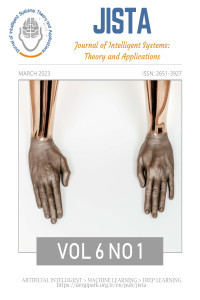Makine Öğrenmesi Teknikleri ile Counter-Strike: Global Offensive Raunt Sonuçlarının Tahminlenmesi
Espor, Makine Öğrenmesi, Sınıflandırma Algoritmaları, Kazanan Tahminleme, CSGO
Prediction of Counter-Strike: Global Offensive Round Results with Machine Learning Techniques
Esports, CSGO, Machine Learning, Classification Algorithms, Winning Prediction,
___
- Ali, P. J. M., Faraj, R. H., Koya, E., Ali, P. J. M., & Faraj, R. H. (2014). Data normalization and standardization: a technical report. Mach Learn Tech Rep, 1(1), 1-6.
- Bengio, Y., Courville, A. C., & Vincent, P. (2012). Unsupervised feature learning and deep learning: A review and new perspectives. CoRR, 1(2665), 2012.
- Biau, G., & Scornet, E. (2016). A random forest guided tour. Test, 25(2), 197-227.
- Boyd, K., Eng, K. H., & Page, C. D. (2013, September). Area under the precision-recall curve: point estimates and confidence intervals. In Joint European conference on machine learning and knowledge discovery in databases (pp. 451-466). Springer.
- Böhning, D. (1992). Multinomial logistic regression algorithm. Annals of the institute of Statistical Mathematics, 44(1), 197-200.
- Chen, T., He, T., Benesty, M., Khotilovich, V., Tang, Y., Cho, H., & Chen, K. (2015). Xgboost: extreme gradient boosting. R package version 0.4-2, 1(4), 1-4.
- Cunningham, P., & Delany, S. J. (2021). K-nearest neighbour classifiers-a tutorial. ACM Computing Surveys (CSUR), 54(6), 1-25.
- Davis, W. (2021). As esports grows, so too do its sponsorships. URL https://win.gg/news/as-esports-grows-so-too-do-its-sponsorships (Erişim tarihi: 28.12.2022)
- Gök, M., 2017. Makine öğrenmesi yöntemleri ile akademik başarının tahmin edilmesi. Gazi Üniversitesi Fen Bilimleri Dergisi Part C: Tasarım ve Teknoloji, 5(3), 139-148.
- Hamari, J. & Sjöblom, M. (2017). What is eSports and why do people watch it? Internet Research, 27(2), 211-232. https://doi.org/10.1108/IntR-04-2016-0085
- Hodge, V. J., Devlin, S., Sephton, N., Block, F., Cowling, P. I., & Drachen, A. (2019). Win prediction in multiplayer esports: Live professional match prediction. IEEE Transactions on Games, 13(4), 368-379.
- Huang, W. X., Wang, J., & Xu, Y. (2022, April). Predicting round result in Counter-Strike: Global Offensive using machine learning. In 2022 7th International Conference on Intelligent Computing and Signal Processing (ICSP) (pp. 1685-1691). IEEE.
- Lillelund, C. (2020). CS:GO round winner classification. URL https://www.kaggle.com/datasets/christianlillelund/csgo-round-winner-classification (Erişim tarihi: 08.12.2022)
- Makarov, I., Savostyanov, D., Litvyakov, B., & Ignatov, D. I. (2018). Predicting winning team and probabilistic ratings in “Dota 2” and “Counter-Strike: Global Offensive” video games. In International Conference on Analysis of Images, Social Networks and Texts (pp. 183-196). Springer, Cham.
- Minka, T.P., Cleven, R., & Zaykov, Y. (2018). TrueSkill 2: An improved Bayesian skill rating system. Technical Report. https://www.microsoft.com/en-us/research/uploads/prod/2018/03/trueskill2.pdf
- Noble, W. S. (2006). What is a support vector machine?. Nature Biotechnology, 24(12), 1565-1567.
- Priyam, A., Abhijeeta, G. R., Rathee, A., & Srivastava, S. (2013). Comparative analysis of decision tree classification algorithms. International Journal of current engineering and technology, 3(2), 334-337.
- Ray, S. (2019, February). A quick review of machine learning algorithms. In 2019 International conference on machine learning, big data, cloud and parallel computing (COMITCon) (pp. 35-39). IEEE.
- Sevli, O. (2022). Farklı sınıflandırıcılar ve yeniden örnekleme teknikleri kullanılarak kalp hastalığı teşhisine yönelik karşılaştırmalı bir çalışma. Journal of Intelligent Systems: Theory and Applications, 5(2), 92-105.
- Shen, Q. (2022, February). A machine learning approach to predict the result of League of Legends. In 2022 International Conference on Machine Learning and Knowledge Engineering (MLKE) (pp. 38-45). IEEE.
- Statista. (2023). eSports market size worldwide in 2021, with a forecast for 2022 and 2029. URL https://www.statista.com/statistics/1256162/global-esports-market-size/ (Erişim tarihi: 04.01.2023)
- UOK. (2023). IOC confirms Singapore as host of first Olympic Esports Week in June 2023. URL https://olympics.com/en/news/ioc-confirms-singapore-host-first-olympic-esports-week-june-2023 (Erişim tarihi: 08.01.2023)
- Xenopoulos, P., Coelho, B., & Silva, C. (2021). Optimal Team Economic Decisions in Counter-Strike. arXiv preprint arXiv, abs/2109.12990.
- Xenopoulos, P., Doraiswamy, H., & Silva, C. (2020, December). Valuing player actions in counter-strike: Global offensive. In 2020 IEEE International Conference on Big Data (Big Data) (pp. 1283-1292). IEEE.
- Yang, B. (2018). Predicting e-sports winners with machine learning. URL https://blog.insightdatascience.com/hero2vec-d42d6838c941 (Erişim tarihi: 22.12.2022)
- Zhang, H., & Li, D. (2007, November). Naïve Bayes text classifier. In 2007 IEEE international conference on granular computing (GRC 2007) (pp. 708-708). IEEE.
- Zhang, Z. (2016). Introduction to machine learning: k-nearest neighbors. Annals of Translational Medicine, 4(11), 218.
- Zhu, X., & Goldberg, A. B. (2009). Introduction to semi-supervised learning. Synthesis lectures on artificial intelligence and machine learning, 3(1), 1-130.
- Başlangıç: 2018
- Yayıncı: Özer UYGUN
Müberra Beyza ODABAŞI, Merve CENGİZ TOKLU
Kampüs İçi Kapalı Alanlarda Hava Kalitesinin Modellenmesi ve Karar Destek Sistemi Geliştirilmesi
Makine Öğrenmesi Teknikleri ile Counter-Strike: Global Offensive Raunt Sonuçlarının Tahminlenmesi
Q-Learning Algoritmasının Öğrenme Hızı Parametresi için Kendine Uyarlamalı Yöntemler parametresi
Murat Erhan ÇİMEN, Zeynep GARİP, Yaprak YALÇIN, Mustafa KUTLU, Ali Fuat BOZ
Analyzing Big Social Data for Evaluating Environment-Friendly Tourism in Turkey
Mahmud ALRAHHAL, Ferhat BOZKURT
Optimal Reaktif Güç Dağıtımı için Equilibrium Optimizasyon Algoritması
İsmail GÜNEY, İhsan Hakan SELVİ
Akıllı Ev Sistemleri için XGBoost Tabanlı Saldırı Tespit Yöntemi
0-1 Sırt Çantası Problemi İçin İkili Bal Porsuğu Algoritması
